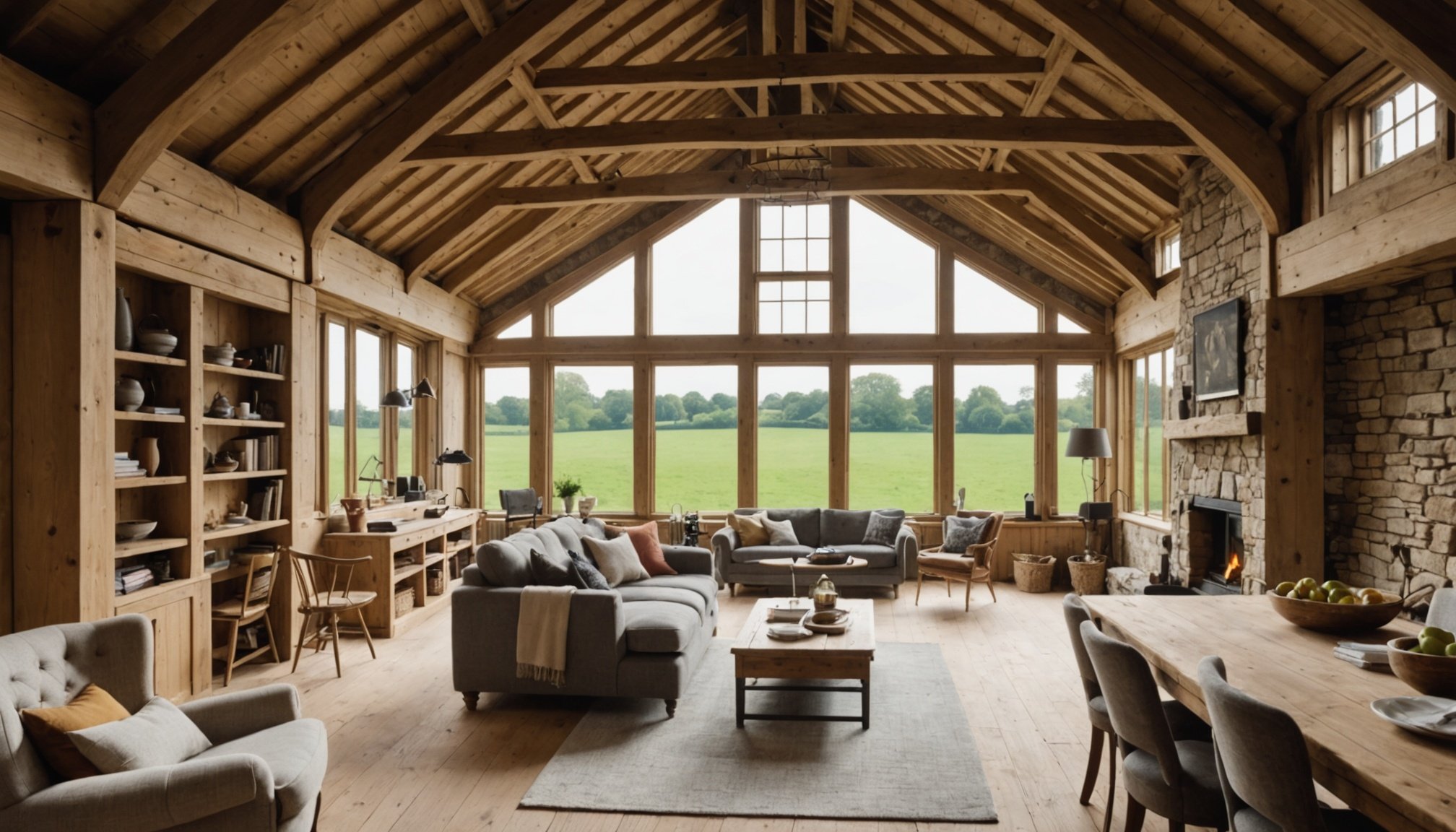Transforming UK Barns: Top Strategies for Crafting a Cozy Livable Space
Converting an old barn into a cozy and livable space is a dream shared by many, especially those who appreciate the rustic charm and the potential for a unique country living experience. Here’s a comprehensive guide on how to transform a UK barn into your ideal home, covering everything from the initial planning to the final decorative touches.
Understanding the Basics of Barn Conversions
Before diving into the transformation process, it’s crucial to understand the basics of barn conversions. Here are a few key points to consider:
Cela peut vous intéresser : Top cocktail poster designs to elevate your home decor style
Planning Permission
One of the first steps in converting a barn is to secure the necessary planning permission. This can be a complex process, especially if the barn is listed or located in a conservation area. It’s essential to work closely with local authorities and possibly hire a professional to navigate these regulations[3].
Structural Integrity
The structural integrity of the barn is paramount. This involves assessing the condition of the existing timber frame, roof, and foundations. For instance, the craftspeople from The German Carpentry have been praised for their dedication in crafting new oak frames and restoring old timber frames in barns like Downland Barns by McLean Quinlan[1].
A voir aussi : What creative ways can you use chalk paint in a UK shabby chic decor?
Budgeting
Barn conversions can be costly, so it’s vital to set a realistic budget and stick to it. This includes costs for materials, labor, and any necessary permits or consultations.
Designing Your Barn Conversion
Design is a critical aspect of any barn conversion. Here are some tips to help you create a space that is both functional and aesthetically pleasing:
Room Ideas and Layout
When designing the layout of your barn conversion, consider the flow of the space and how each room will be used. Here are some room ideas to get you started:
- Living Room: This is often the heart of the home. Consider large windows to let in natural light, and a fireplace or wood stove for a cozy feel.
- Kitchen: A well-designed kitchen is essential. Think about incorporating rustic elements like wooden beams and stone countertops.
- Garden Room: A garden room can be a beautiful addition, providing a seamless transition between indoors and outdoors.
- Sitting Room: This can be a quiet space for reading or relaxation, often with a smaller footprint but plenty of character.
| Room Type | Key Features |
|
|-----------------------------------------------------------------------------|
| Living Room | Large windows, fireplace or wood stove, comfortable seating area |
| Kitchen | Rustic elements (wooden beams, stone countertops), modern appliances |
| Garden Room | Large windows, sliding doors, natural materials (wood, stone) |
| Sitting Room | Cozy seating area, bookshelves, natural light |
Home Decor and Country Living
To achieve that perfect country living look, focus on incorporating natural materials and rustic elements into your design.
- Wood Accents: Exposed wooden beams and wooden flooring can add a warm, rustic feel to your space.
- Natural Light: Maximize natural light by installing large windows and skylights.
- Home Decor: Use home decor items that reflect the country setting, such as vintage furniture, natural textiles, and earthy color schemes.
Practical Considerations for Barn Conversions
While the design aspect is exciting, there are several practical considerations to keep in mind:
Insulation and Heating
Barns can be cold and drafty, so proper insulation and heating systems are crucial. Consider using eco-friendly insulation materials and installing a efficient heating system, such as underfloor heating or a biomass boiler.
Electrical and Plumbing
Upgrading the electrical and plumbing systems is often necessary. This may involve hiring professionals to ensure that the systems meet modern standards and safety regulations.
Garden and Outdoor Spaces
The garden and outdoor spaces are just as important as the interior. Here are some ideas to create a beautiful and functional outdoor area:
- Native Planting: Use native plants to create a garden that blends seamlessly into the surrounding countryside.
- Summer House: Consider adding a summer house or a small barn as an additional living space or storage area.
- Outdoor Activities: Incorporate outdoor activities such as yoga, nature walks, or even an art forest school, as seen in the innovative approaches by farmers like Eddie Rixon at Lopemede Farm[5].
Case Studies and Inspirational Ideas
Looking at real-life examples can be incredibly inspiring and helpful. Here are a few case studies to consider:
Downland Barns by McLean Quinlan
This project is a prime example of how traditional craftsmanship can be combined with modern design. The use of new oak frames and the restoration of old timber frames highlight the importance of preserving the original character of the barn while making it livable[1].
Lopemede Farm
Eddie Rixon’s approach at Lopemede Farm shows how barn conversions can be integrated into a broader strategy of agritourism and community engagement. By opening up the farm to various activities, Rixon has created a sustainable and community-driven model that complements the farm’s agricultural activities[5].
Financial and Environmental Benefits
Barn conversions offer several financial and environmental benefits:
Financial Benefits
- Increased Property Value: A well-executed barn conversion can significantly increase the property value.
- Energy Efficiency: Modern insulation and heating systems can make the barn more energy-efficient, reducing long-term costs.
- Diversified Income: For farmers, incorporating agritourism activities can provide a diversified income stream.
Environmental Benefits
- Sustainable Materials: Using natural and sustainable materials in the conversion process can reduce the environmental impact.
- Energy Savings: Efficient heating and insulation systems can reduce energy consumption.
- Biodiversity: By incorporating native planting and restoring natural habitats, you can enhance biodiversity on your property. and Final Tips
Transforming a UK barn into a cozy and livable space is a rewarding project that requires careful planning, design, and execution. Here are some final tips to keep in mind:
- Hire Professionals: If you’re not experienced in construction or design, it’s wise to hire professionals to ensure the project is done correctly.
- Stay Flexible: Be prepared for unexpected challenges and stay flexible with your design and budget.
- Enjoy the Process: Remember to enjoy the journey of transforming your barn into your dream home.
| Final Tips | Description |
|
|-----------------------------------------------------------------------------|
| Hire Professionals | Ensure expertise in construction and design |
| Stay Flexible | Be prepared for unexpected challenges |
| Enjoy the Process | Appreciate the journey of transforming your barn |
By following these strategies and considering the practical, financial, and environmental aspects, you can create a beautiful and functional living space that reflects the unique charm of a UK barn. Whether you’re looking to create a cozy living room, a spacious garden room, or an entire country home, the possibilities are endless, and with the right approach, your barn conversion can become your dream home.
Essential Renovation Techniques
Renovating a barn into a functional and beautiful space requires strategic planning and execution. With the right barn renovation techniques, you can transform old structures into vibrant living areas.
Structural Changes
Before diving into aesthetic upgrades, it’s crucial to assess the structural integrity of your barn. Inspections should focus on the strength of beams and columns, as well as the foundation’s stability. Identifying any weaknesses early can prevent costly repairs in the future and ensure that the renovation is safe and long-lasting. Proactively addressing structural changes is an effective way to preserve the original charm while meeting modern standards.
Insulation and Energy Efficiency
To maximize comfort, incorporating effective insulation practices is essential. Using materials that provide superior thermal performance can maintain a stable indoor temperature, crucial for comfort throughout the seasons. It’s also beneficial to consider eco-friendly insulation options, such as recycled denim or wool, which help to improve energy efficiency while reducing environmental impact.
Sustainable Materials
Choosing sustainable materials plays a significant role in barn renovation. Opt for resources like reclaimed wood, bamboo, or cork. These eco-friendly materials not only align with sustainable building practices but also add a unique aesthetic to your barn, making it both a functional and environmentally conscious haven.











